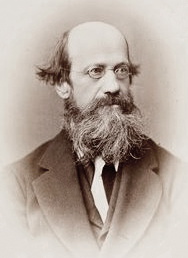Joseph Lovering facts for kids
Quick facts for kids
Joseph Lovering
|
|
|---|---|

Lovering circa 1868–1875
|
|
| Born | 25 December 1813 |
| Died | 18 January 1892 Boston, Massachusetts
|
| Nationality | American |
| Alma mater | Harvard University (A.B., 1833) |
| Scientific career | |
| Fields | Mathematics |
| Institutions | Harvard University |
| Academic advisors | Benjamin Peirce |
| Doctoral students | John Trowbridge |
Joseph Lovering (born December 25, 1813 – died January 18, 1892) was an important American scientist and teacher. He spent most of his career at Harvard University, where he taught mathematics and natural philosophy.
Contents
A Life of Learning and Teaching
Joseph Lovering finished his studies at Harvard University in 1833. Just five years later, in 1838, he became the Hollis Professor of mathematics and natural philosophy at Harvard. This was a very important teaching position. He kept this job for 50 years, until 1888, when he became a Professor Emeritus. This means he was honored for his long service and could still be part of the university.
He also served as an acting regent of the university from 1853 to 1854. A regent is like a leader or manager who helps run the university.
Scientific Research
From 1884 to 1888, Lovering was the director of the Jefferson Physical Laboratory. He also worked closely with the Harvard College Observatory. Here, he helped with important studies on Earth's magnetism. These studies were done together with scientists from the United States and the Royal Society in London.
Leading Scientific Groups
Joseph Lovering was very active in the American Association for the Advancement of Science. This is a big group for scientists in America. He was a secretary from 1869 to 1873. Then, he became a vice president from 1873 to 1880. Finally, he was elected president of the association from 1880 to 1881.
Writing and Editing
Lovering wrote many articles for scientific magazines. He also wrote a book about the Aurora Borealis in 1873. The Aurora Borealis, also known as the Northern Lights, is a beautiful natural light display in the sky. He also helped update a book called Electricity and Magnetism by Professor John Farrar in 1842.
Ideas About Meteors
Joseph Lovering had different ideas about meteor showers than some other scientists of his time. In 1837, professors from Yale University believed that meteor showers happened every August. They thought the Earth passed through a "nest of meteors" each year.
However, Lovering disagreed. He thought that meteors were more related to weather patterns. He did not believe that meteor showers happened on the same dates every year. Instead, he thought that meteors could be seen almost every clear night. He believed they were spread out evenly throughout the year, not just at certain times.
Images for kids


